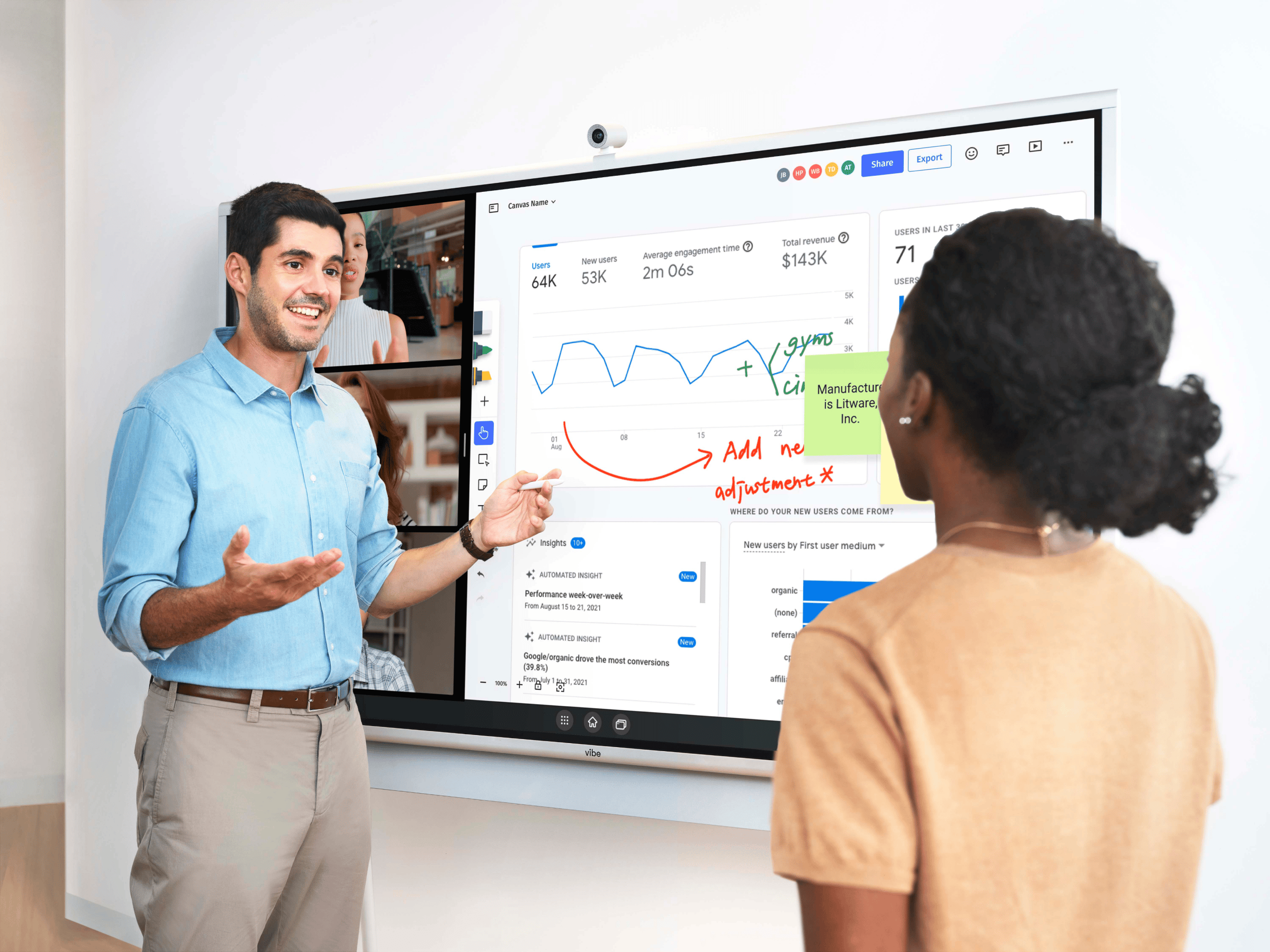Imagine being tasked with explaining a new strategy to senior leadership. Or how about pitching your solution during an important client presentation? Did your pulse just start to race a little? If so, that’s probably because sharing information in a formal, professional capacity can feel extremely high stakes.
In these situations, success depends on more than good ideas—it depends on how well you share them. A business presentation is a structured way to inform, persuade, or inspire an audience using speech, visuals, and storytelling. Done well, it builds trust, influences decisions, and sparks action. In fact, research shows that 70% of professionals who present regularly believe presentation skills are critical to their success at work.
In this guide, we’ll walk you through everything you need to create presentations that stand out—covering objectives, structure, design, delivery, and follow-up—plus how interactive tools can help your presentations resonate more deeply.
- Every business presentation should begin with a clear objective: to inform, persuade, or motivate.
- A single, well-crafted core message ensures focus, clarity, and audience alignment.
- Strong structure—introduction, body, and conclusion—keeps content logical and memorable.
- Visuals should simplify ideas and support the speaker, not compete for attention.
- Confident delivery, thoughtful follow-up, and the right collaboration tools turn good presentations into great ones.
Define Your Objective and Know Your Audience
The first mistake many presenters make is diving into slides before they’ve clarified their objective. Ask yourself: is this presentation meant to inform, persuade, or motivate? Each purpose demands a different approach.
Informative Presentations
-
What it is: Share data, facts, or updates clearly and objectively.
-
Why it matters: Keeps stakeholders aligned and confident in decisions.
-
What it looks like: Quarterly business reviews, annual reports, team briefings, or project updates.
Persuasive Presentations
-
What it is: Convince your audience to support an idea, investment, or decision.
-
Why it matters: Drives business outcomes by turning interest into action.
-
What it looks like: Investor pitch decks, sales presentations, business cases.
Motivational Presentations
-
What it is: Inspire belief, confidence, or new behaviors.
-
Why it matters: Sparks momentum and commitment from teams.
-
What it looks like: Vision-setting meetings, leadership talks, goal-kickoff sessions.

Know Your Audience
Once you know your objective, the next step is to understand your audience. The same content delivered to executives, sales teams, and technical experts may land very differently. As you prepare, be mindful of the different needs and expectations of each group:
-
Executives want concise insights backed by data and impact metrics.
-
Sales teams need clear value propositions and market positioning.
-
Technical teams expect precise details and operational clarity.
A useful rule of thumb is to ask yourself, "What do I want this audience to think, feel, or do when I finish?" Then build everything—slides, words, and delivery—around that outcome.
Crafting a Clear and Compelling Core Message
Behind every great business presentation is a core message: a single, crisp line that encapsulates the central idea you want your audience to remember. You can think of it as your thesis statement, the anchor that keeps every story, statistic, and slide tied to one unifying point.
For example:
-
Inform: "Our Q3 growth shows we’re positioned for market leadership."
-
Persuade: "Investing in this solution will reduce costs by 25% in one year."
-
Motivate: "Together, we can double our impact in the next 12 months."
A strong core message matters because it:
-
Focuses your content so nothing feels random or overwhelming.
-
Improves retention—audiences leave with one clear takeaway.
-
Aligns everyone in the room on purpose and direction.
Every element of your presentation should support this message, and you want it to always be top of mind with your audience. As such, don’t be afraid to repeat or reaffirm it. A simple technique is to restate the message at key points: your opening, your transitions, and your close.
Frameworks for Building Core Messages
Even when you know your core message, shaping it into a structure that’s easy to follow can be challenging. Frameworks provide a logical flow for your narrative, helping your audience quickly grasp the problem and your proposed solutions. Two proven approaches stand out for business presentations:
SCQA Framework (Situation, Complication, Question, Answer)
-
Situation: Describe the current state.
-
Complication: Explain the challenge or disruption.
-
Question: Raise the central problem.
-
Answer: Share your solution—your core message.
-
Example: Flat sales → Rising competition → How do we grow? → By accelerating digital strategy.
SCR Framework (Situation, Complication, Resolution)
-
A streamlined format for executive settings.
-
Moves quickly from problem to solution without extra build-up.
-
Best for decision-makers who need clarity fast.
Both methods give your business presentation a logical backbone and ensure your audience always knows why your message matters. Likewise, an effective framework keeps you disciplined—preventing information overload and ensuring every point connects back to your main idea.
Narrative Structure: Organize with Purpose
A business presentation works best when it follows a simple, logical structure. Think of it as a three-act story. Here are some business presentation tips help you add some narrative to your slides:
1. Introduction
-
10-15% of total presentation time.
-
Grab attention with a hook: a surprising stat, short story, or provocative question.
-
Preview what you’ll cover and why it matters to the audience.
2. Body
-
70-75% of total presentation time.
-
Present your main points in sequence, using data, visuals, and examples.
-
Frame content in a problem–solution format for clarity.
-
Use transitions to connect ideas so the audience never feels lost. For example, try bridging phrases like:
-
"This brings us to the next key question—and why the timing matters now."
-
"Building on that momentum, here’s what we learned when we scaled the pilot."
-
"Now that we’ve clarified the problem, let’s walk through the solution and its impact."
-
"Before moving on, here’s the takeaway in one line—now let’s apply it to the next step."
-
3. Conclusion
-
10-15% of total presentation time.
-
Summarize the key takeaways in simple terms.
-
Reinforce your core message one last time.
-
Provide a clear call to action—what should they do next?
When in doubt, just remember that shorter is better. A clear flow ensures your business presentation is remembered for your insights (and not for its length).

Visuals that Support, Not Distract
Slides are meant to guide attention and reinforce your message, but too often they end up competing with the presenter. The best visuals are those that simplify complex ideas, make data easier to grasp, and keep your audience focused. In other words, clear, concise visualization transforms raw numbers into compelling data storytelling that decision-makers can quickly act on. Here are a few best practices:
-
Focus on one idea per slide.
-
Replace text walls with high-quality images or charts.
-
Apply the 10/20/30 rule (no more than 10 slides, 20 minutes, 30-point font).
-
Maintain brand consistency in fonts, colors, and logos.
-
Use animations sparingly to highlight—not clutter—key points.
Data Visualization Tips
-
Stick to simple charts (bar, line, pie).
-
Highlight the insight instead of getting caught up in every data point.
-
Label clearly and keep scales honest.
Storytelling Through Visuals
-
Show "before and after" or "problem vs. solution" graphics.
-
Align visuals with your spoken words to reinforce impact.
Accessibility Considerations
-
Use high contrast and readable fonts.
-
Avoid red/green combos that might exclude colorblind viewers.
-
Offer verbal descriptions of visuals for inclusivity.
Interactive tools like Vibe allow presenters to annotate in real time, run side-by-side comparisons, and keep visuals engaging—without overloading the audience.
Confident Delivery and Audience Engagement
A polished slide deck won’t help if delivery falls flat. Confident presenters prepare both what they’ll say and how they’ll say it.
-
Practice until you can speak without reading slides. Recording yourself helps catch pacing or filler words.
-
Use natural body language: maintain eye contact, vary tone, and gesture for emphasis.
-
Aim for an optimal speaking pace of 150–160 words per minute; slow to 120–140 WPM for complex data, and pause 1–2 beats after key points so they land.
-
Keep the focus on the audience by using "you" and "we" instead of "I."
-
Maintain camera/audience eye contact about 60–70% overall; with small rooms, rotate contact every 3–5 seconds per person, and with larger groups, scan in zones (left–center–right) pausing 2–3 seconds per zone.
-
Prepare for Q&A by anticipating objections and practicing clear, concise responses.
-
Read real-time feedback: if heads tilt or brows furrow, simplify and slow; if note-taking stops and eyes drift, increase energy, ask a check-in question, or move to a visual/demo to re-engage.
Engagement is about dialogue, not monologue, and strong delivery is what drives meaningful client engagement. Tools like real-time annotations and interactive canvases allow presenters to respond live to audience questions, making presentations more collaborative and memorable.
Post-Presentation Follow-Up
Your business presentation doesn’t end when the slides close. Effective follow-up builds momentum and helps your ideas take root.
-
Ideally, follow up with 24-48 hours for best results.
-
Send a thank-you email with slides or key notes.
-
Reiterate the main takeaways and next steps.
-
Provide resources, links, or deadlines to keep progress moving.
-
With top-end platforms like Vibe, presentations save instantly to the cloud, making it easy for teams to revisit discussions and continue collaboration without losing any of the essential context.
This is a foundational aspect of client communication, but can be just as valuable for strengthening internal alignment across departments.
Common Presentation Mistakes and How to Avoid Them
Even strong presenters slip into habits that weaken impact. Unfortunately, even small missteps can make an audience lose focus, tune out, or leave without understanding the key message. The good news is that these challenges are easy to spot and correct once you know what to look for. Avoid these pitfalls:
-
Overloading slides: Too much text overwhelms. Stick to one idea per slide.
-
Poor time management: Practice with a timer and leave room for Q&A.
-
Failing to read the room: Watch body language and adapt if energy dips.
-
Weak openings: Always start with a hook; never start with a disclaimer.
-
Unclear calls to action: Be direct about next steps.
-
Tech dependency without backup: Always carry an offline version; tools like Vibe reduce risks with offline sync and smooth recovery.
Continuous Improvement and Learning
Presentation mastery doesn’t happen overnight—it’s a skill built through consistent practice and reflection. Each presentation is a learning opportunity, giving you insight into what worked and what didn’t so you can refine your approach. After the business presentation is over, be sure to:
-
Ask for feedback from peers or mentors.
-
Watch recordings of yourself to refine pacing and tone.
-
Join groups like Toastmasters for practice and feedback.
-
Use digital tools (speech analyzers, timers) to sharpen delivery.
-
Consider working with a presentation coach for high-stakes moments.

Succeeding in Virtual Presentations
Remember when remote and hybrid workforces were nearly unheard of in most industries? Those days are past; today, more presentations happen online than ever, and that means you need to build your business presentation around the needs of a remote audience. Here’s how to succeed virtually:
-
Choose the right platform: Test Zoom, Teams, Meet, etc. for compatibility with slides, video, and polls.
-
Engage remote audiences: Use polls, Q&A, or breakout rooms. Maintain energy by speaking to the camera. If you’re presenting to a hybrid group (with some of your audience in person and others interacting remotely), be sure to repeat questions, comments, and reactions from the room so remote participants aren’t excluded from the flow of the conversation
-
Optimize your setup: Good lighting, a quality microphone, and a distraction-free background matter more than fancy effects.
-
Practice technology: Rehearse screen-sharing, chat management, and muting.
-
Simplify visuals: Those watching on small screens require bold fonts and uncluttered slides.
-
Leverage collaboration tools: Vibe’s interactive boards, stylus input, and AI camera keep hybrid sessions engaging, making it easier to collaborate in real time.
Vibe Board S1: The Interactive Business Presentation Platform
We’ve seen how preparation, delivery, and design can make or break a business presentation. But tools matter too. That’s where the Vibe Board S1 comes in—a smart presentation hub built for hybrid teams.
With Vibe, presenters can:
-
Brainstorm on an infinite whiteboard using Vibe Canvas to capture ideas without space limits.
-
Annotate slides in real time, adding context and responding to audience questions on the spot.
-
Save everything instantly to the cloud, so no progress or notes are ever lost.
-
Present naturally with AI camera and stylus support, whether sketching concepts or leading workshops.
-
Integrate seamlessly with 200+ apps including Zoom, Microsoft Teams, and Google Workspace, so Vibe fits into your workflow instead of disrupting it.
-
Make sessions more collaborative and engaging with interactive features like live annotations and split-screen views that keep both in-person and remote audiences involved.
A strong business presentation gives your audience clarity and direction. More than that, it solves problems. By shaping a core message and delivering it with confidence, you create the foundation for meaningful impact. With the Vibe Board S1, you can elevate those moments, making every presentation more interactive and memorable.
Whether you’re informing, persuading, or motivating, Vibe ensures your message comes through clearly. Ready to elevate your business presentations? Request a demo today.
 Team using a Vibe Board to conduct an engaging business presentation.
Team using a Vibe Board to conduct an engaging business presentation.Business Presentation FAQs
What is a business presentation?
A business presentation is a structured way of sharing information with a group—designed to inform, persuade, or inspire. It combines visuals, speech, and storytelling to achieve a specific outcome.
What is the 5-5-5 rule for presentations?
This guideline helps keep slides simple: 5 words per line, 5 lines per slide, and no more than 5 text-heavy slides in a row. It ensures the audience stays focused on you and your message.
How do you write a business presentation example?
Start with your goal. Outline an intro, body, and conclusion. Add visuals that reinforce each main point. End with a clear call to action. For example, a sales pitch business presentation might open with a customer problem, explain your solution, show proof of value, and close with next steps.
What are the 3 main types of business presentations?
The three primary types are informative, persuasive, and motivational. Informative presentations share knowledge, persuasive presentations aim to convince an audience, and motivational presentations inspire action.
How long should a business presentation be?
Often, the most-effective business presentations are those that last between 15–20 minutes, plus time for Q&A. That said, some types of presentations (such as technical presentations) may need to be longer. The ideal length depends on the subject and the audience’s expectations, but shorter, more focused talks are typically easier to retain.
What is a multimedia presentation?
A multimedia presentation combines text, visuals, video, and audio to deliver a message. This approach is especially useful in remote or hybrid settings where varied content helps sustain attention.









-1sbltxxq4FYxHrXrwJVLsCDNsXpqNa.webp)
-5Zp0pmSytvcuYDVs1LvuwplKuRneK0.webp)
